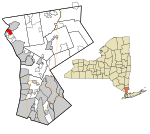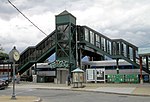The Aaron Copland House, also known as Rock Hill or Copland House, is the former home of composer Aaron Copland for the last 30 years of his life, and now also a creative center for American music. Located on Washington Street in Cortlandt Manor, New York, United States. Built in the 1940s, the house and its garage were listed on the National Register of Historic Places in 2003, and five years later, in 2008, they were designated a National Historic Landmark, the only one in the country connected to a figure from the world of classical music. The grounds below Copland's home consist of a two-tiered garden ringed by natural woods, and in 2009, the National Wildlife Federation designated the property a Certified Wildlife Habitat.Copland began retreating to the country during weekends and summers in the 1930s. He found the experience of rural living beneficial to his composing, and after a series of residences, purchased the modernist ranch-style house in the 1960s to live there full-time. Its style has been described as consistent with Copland's music. After his death in 1990, the Copland Heritage Association, now Copland House, Inc., was established to preserve the building.
Its composer-in-residence program, known as the Copland House Residency Awards, began in November 1998 and is an official project of the federal Save America's Treasures program. It awards six to nine emerging or mid-career American composers the opportunity to work and reside, one at a time, at Rock Hill. Composers who apply and are approved, are afforded three-to-eight-week stays in the house, with an allowance for food and the use of a car, while they work. They may share the house with spouses or partners, but not children or dogs. Allen Shearer was the first composer in residence in late 1998. Other previous winners include Pierre Jalbert, Richard Danielpour, Robert Xavier Rodriguez, Robert Paterson, Judith Lang Zaimont, Andrew Norman, Derek Bermel, Du Yun, Henry Threadgill, Alvin Singleton, Dave Douglas, Christopher Theofanidis, Jorge Villavicencio Grossmann and Hannah Lash.In 1999, Copland House initiated its resident chamber ensemble Music From Copland House (MCH), the U.S.'s only wide-ranging American repertory ensemble, which made its debut at the Opening Night of Merkin Concert Hall’s 1999-2000 season.In September 2009, Copland House at Merestead, the organization's regular mainstage concert series, was established at the historic Merestead Estate in Mount Kisco, New York.










